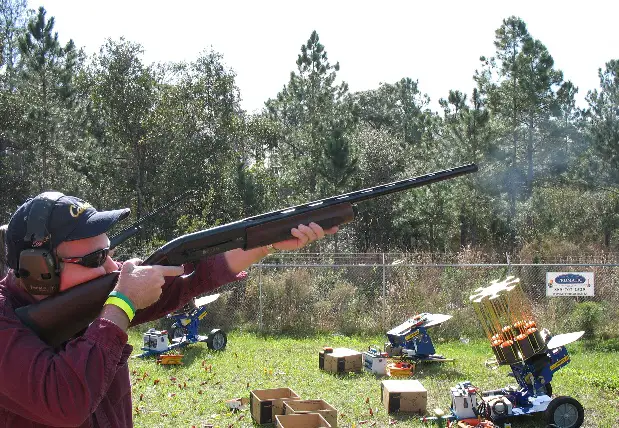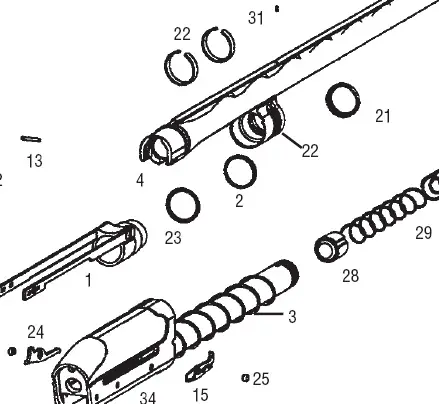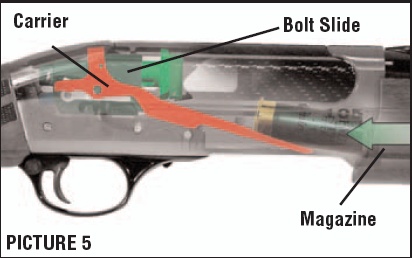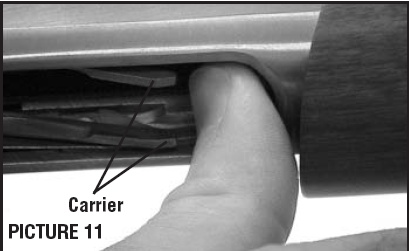


First Glance: 2007 Remington 105CTi 12 Gauge Autoloader

There has been a lot of talk about Remington's first substantially new autoloading shotgun since their 1100 that was the most popular semi-auto ever released. It is over forty years old by now, and what was once an instant hit is now considered a bit long in the tooth. The 'classic' 1100 currently offered is the "Sporting 12," a 2-3/4 in. chambered model that tips the scales at a stated eight pounds with its "Light Contoured Barrel," with an MSRP of $1057. That best defines the gun that we all feel in love with four decades ago-- a good looking gun that ruled the skeet fields, showed us little recoil, and came at a time when 1-1/8 oz. was "the" 12 gauge load. Times have changed since then, and we think we can no longer tolerate an eight pound gun in the field. Many find a 2-3/4 inch chamber limiting, though 2-3/4 inch 12 gauges have filled more limits than any other combination over the last 100 years.
Remington apparently knew the 1100 wouldn't compete forever, and the 11-87 was Remington's 1987 attempt to update their old flagship semi-auto. It didn't work well, Remington stuttered and alternatively discontinued and re-introduced various 1100 models ever since. The weight of the gun was never addressed, nor was the O-ring gas assembly that, rightly or wrongly, has gained its fair share of ridicule over recent decades. Cycling 1 to 1-7/8 oz. 12 gauge shells in three inch chambers has become standard, expected fare from Browning and Beretta with no user-adjustments, along with magazine cut-offs, shim-adjustable stocks, and the like. For over forty years, Remington ignored these trends--being the last of the major shotgun makers to offer screw-chokes as well.
Well, 2007 has arrived, and the long-awaited Remington 105CTi (model 2005, carbon titanium) finally started shipping very late last year. It was introduced at the 2006 Shot Show, and introduced again this year in Orlando. The primary touted features are the skeletonized carbon-titanium receiver, bottom eject, an oil-filled shock absorber strut inside the buttstock, and a carbon fiber rib. The idea is to save weight, down to a claimed 7 lbs. from previous Remington autoloaders while still being soft shooting. The MSRP is a hefty $1511, a bit salty compared to many, many models from industry leaders Beretta and Browning. Clearly lighter than the 8 - 8-1/4 pound 1100 and 11-87 genre, it is within an ounce or two of standard Beretta 391 models, and may actually be an ounce heavier than the standard Browning Superlight Hunter. Remington adds the same nauseating hyperbole as other manufacturers as far as "overbored barrels" and "lengthened forcing cones." Remington is no better or worse than the others. Obviously, the bore of the 105CTi has never changed since it was first released, meaning right now, and the 105's forcing cones are no longer or shorter than they ever were. Remington's .735 inch bore barrel can be overbored if you choose it to be; compared to a .742 in. Browning barrel it is under-bored.
The bottom ejection is a feature that has never really caught on with the masses. Remington tired of making the John Browning designed Model 17 long ago, the bottom ejecting 20 ga. that became the Ithaca Model 37 around the year you would guess, 1937. Bottom ejection is not something Remington has ever mentioned when selling 870's against the Browning BPS, the most common bottom-ejector of today. One benefit is, when coupled with a tang safety (as in the BPS) it makes the gun ambidextrous. No autoloader can really achieve that, with an exposed cocking lever on one side of the action, as is the case with the 105CTi.
Hefting, swinging, and shooting the 105CTi gave me some distinct impressions. Yes, the 105 CTi is an extremely soft shooter, perhaps a tad softer than a factory Browning or Beretta with a standard pad, but I can't call any of them anything less than pleasant. Add a Kick-Eez or Limbsaver pad to the "B" guns (a proprietary Limbsaver comes on the Remington from the factory) and it is highly unlikely to be tangible. As supplied, as fired, though, it is a very soft shooting gun.
I found the "tournament" trigger on the 105CTi to be better than other Remington triggers, clearly better than out-of-the box Browning Golds, but no better than the Beretta 391 Urika 2 I shot the same day. It is a far better than average factory shotgun trigger, particularly in today's peculiar environment.
The Remington CTi did not fit me well. Unfortunately, unlike Beretta and Browning models that have shim-adjustable buttstocks, Remington has ignored that feature. It is a big negative as far as I'm concerned: it either fits you, or you need stock work.
I have a hard time characterizing the "new" Remington gas system as anything but crude by today's standards. It is not a compensating system, and I was cautioned by Remington that 1200 fps 1-1/8 oz. loads were the bare minimum required for reliable function. Many will ask if the 105 has O rings: well, yes and no: it has rubber gaskets:


Remington refers to these gas system parts as "#2 Action Sleeve Seal," "#21 Gas Cylinder Seal," and "#23 Inner Seal." Apparently, no O rings-- but a lot of loose parts that are supposed to be sealing, in any case. The oil-filled shock absorber rod that enters the buttstock is designated as the "Rate Controller."
The inability to cycle light loads with three inch chambered autoloaders has plagued the 1100 for years, continued to a mitigated extent with the 11-87's 'barrel seal activator' if you remember to stick it in (used in 20 ga. and Super Magnum Models), and it is now back in full fury with the 105 CTi. I can only presume that with the many delays in shipping this model, there was great pressure to get it out the door whether ready for prime time or not. Remington advised me that this was considered a "field" model, and that clays models (likely with 2-3/4 in. chambers) were in the works.
The Remington loads from the bottom with a speed-loading feature that I found a bit clumsy, not at all as intuitive as an A-5 or Browning Gold. Speed loading has been around for a very long time, becoming popular when Browning added the "two piece shell carrier" to their A-5. Browning 'Double Autos' had it, with the gas-operated Browning B2000 having both speed loading and speed unloading as well. It is featured on the Browning Gold, as well, since it was introduced in 1994, with the option of the first shell going directly into the chamber.

With the 105 CTi, it seems the shell goes forward into the magazine tube first, the only way it can be loaded as you have no open conventional breech. Not too far, though, and then the magazine tube spring shoots the shell back in the base of the receiver, finally being carried upstairs by the double fingers of the carrier. It is clumsier than the Browning treatments, at least in my clumsy hands, as it was very easy to go too far and just load the magazine tube. Perhaps it is an acquired taste, perhaps the solid metal flap of the Gold just made it easier for me than the open "fingered" carrier of the 105 that Remington calls "Turbofeed" when attempting speed-loading. It takes scant little attention to load a Gold or A-5 on the dove field or skeet field without looking. The 105 required much more care and examination. I sure exactly alone in this observation-- a lot of shooters had their 105s flipped over, staring at the bottom to "speed load." With a Gold, you'd be continuously busting clays without hesitation and not flipping the shotgun belly-up. I've often done just that.

The unusual looks of the receiver leave little room for middle of the road feelings. Some might feel it spacey, cool and nouveau, but I found it very hard to look at. The change from the rough-looking, fabricy texture to smooth blued steel was far more than I could bear. It is remarkably homely, to my eyes, when compared to the 1100.
The Remington 105CTi is pricey, it does not handle the broad spectrum of shells well, the speed-loading lacks ease, and the stock is a matter of it just fits you or you are quickly out of luck, at least out of the box. My impression is that this model really isn't remotely competitive with pre-existing Beretta and Browning product by any reasonable standards, and could not be without a radical rethinking of the gas system, at the very least.
Copyright 2007 by Randy Wakeman. All Rights Reserved.

Custom Search




